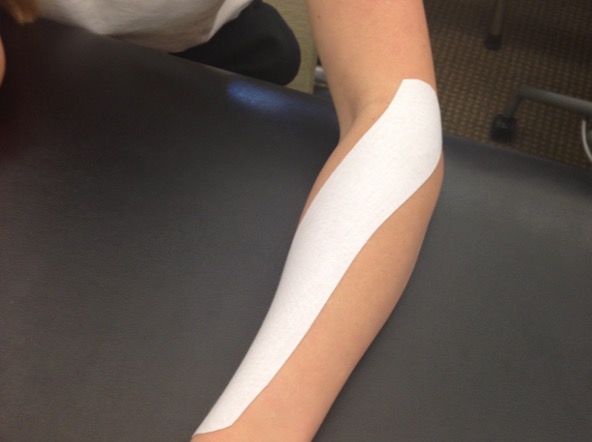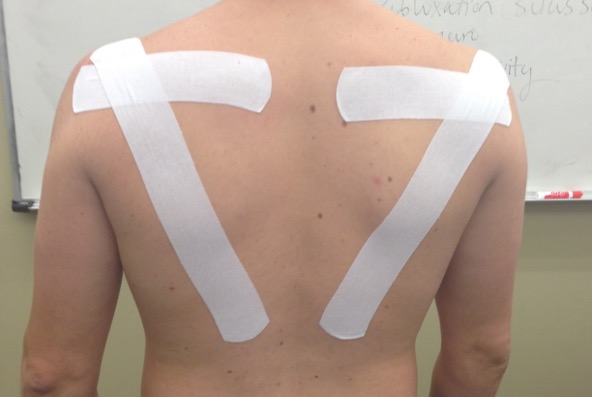Mandy Blackmon, PT, DPT, OCS, CMTPT
I love using tape as one of the interventions in the treatment of my patients with both acute and chronic pain conditions. My entry-level physical therapy students often joked that if I couldn’t fix it with dry needling and tape, it probably couldn’t be fixed. Although that’s a simplification of my approach to treatment, there is a grain of truth in the statement.
Tape often gets a bad rap in our “evidence-based practice” schematic in the allied health and medical world in which we function. In randomized controlled studies, tape is often compared to one or two other interventions used in isolation. I would assert that this is faulty, non-pragmatic study design, as an experienced clinician would never utilize tape as a singular intervention. Rather, I like to think of tape as the “icing on the cake” of my group of interventions used to target a particular impairment or pain presentation.
That said, there are three recent articles comparing taping to dry needling and/or lidocaine injections in upper quarter pain syndromes (upper trap MFP and lateral epicondylalgia). (Kara et al., Altas, et al. Bagheri et al.) All three studies showed improvements in pain scale and/or pain pressure threshold with all interventions. Two studies also showed improvements in subjective functional outcome tools with both interventions. Do these studies demonstrate that we could utilize taping as our only treatment? Absolutely not.
 As with any intervention, we must ponder the why and how of any treatment we implement. For example, in the case of utilizing dry needling (DN) for a patient presenting with lateral epicondylalgia, what muscles are we targeting? Typically, I’d want to inhibit the upper trapezius, infraspinatus, and triceps, all of which are likely overworking and may be causing direct pain referral patterns to the elbow. Supinator and ECRB/L may also be overworking in this patient population. Similarly, I may want to target supraspinatus, middle trap, and lower trap to facilitate these muscles to “turn on” and improve muscle activation patterns. My interventions following this dry needling process should be a continuation of these inhibition/facilitation goals. For example, I may “kinesiology tape” in the dorsal forearm with an inhibitory technique (light stretch from insertion toward origin).
As with any intervention, we must ponder the why and how of any treatment we implement. For example, in the case of utilizing dry needling (DN) for a patient presenting with lateral epicondylalgia, what muscles are we targeting? Typically, I’d want to inhibit the upper trapezius, infraspinatus, and triceps, all of which are likely overworking and may be causing direct pain referral patterns to the elbow. Supinator and ECRB/L may also be overworking in this patient population. Similarly, I may want to target supraspinatus, middle trap, and lower trap to facilitate these muscles to “turn on” and improve muscle activation patterns. My interventions following this dry needling process should be a continuation of these inhibition/facilitation goals. For example, I may “kinesiology tape” in the dorsal forearm with an inhibitory technique (light stretch from insertion toward origin).
 Similarly, I may use strapping tape OR a facilitatory kinesiology taping technique to reset the scapular position and/or activate lower and middle trapezius. We refer to this as the “scap 7 tape.”
Similarly, I may use strapping tape OR a facilitatory kinesiology taping technique to reset the scapular position and/or activate lower and middle trapezius. We refer to this as the “scap 7 tape.”
There are several other variables to be considered when choosing if and when to tape, as well as what techniques to utilize. In the hypermobile population, dry needling of active trigger points may remove some of the contractile stability around a joint. Taping may provide external stability and proprioceptive input to assist the patient when performing prescribed therapeutic exercises and neuromuscular re-education movements.
However, many of these patients have skin sensitivities and may react to certain adhesives used in many brands of tape. A patch test and or barrier sprays such as Skin Prep should be used in this population. The clinician must also consider the activities a patient will be participating in after treatment. Do they need full range of motion in that extremity to participate in their sport? Are they swimming or exercising in water? Are they participating in an activity such as dance where the tape may be an aesthetic concern? These considerations allow a clinician to get creative and have fun with taping techniques. As stated previously, taping should never be used as a singular intervention. Rather, it is a great adjunct to dry needling and other manual and exercise interventions we implement regularly in our practices.

